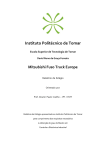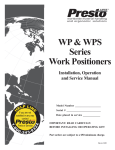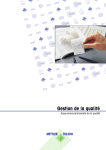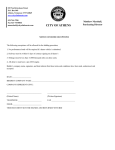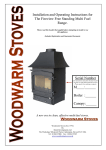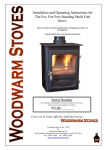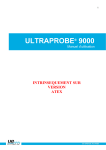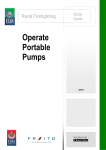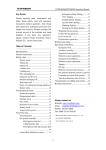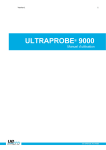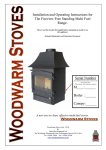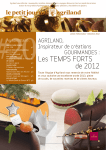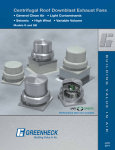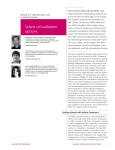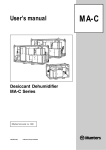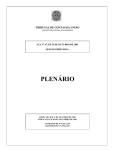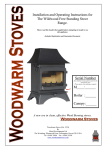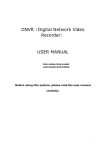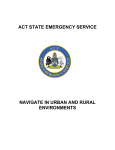Download Rural Fire Appliance Medimum Ops and Tech Requirements vs
Transcript
Guidelines for Operational and Technical Requirements NEW ZEALAND RURAL FIRE “MEDIUM” APPLIANCE Version 5A – March 2012 National Rural Fire Authority PO Box 2133 Wellington New Zealand Guidelines for Operational and Technical Requirements NEW ZEALAND RURAL FIRE “MEDIUM” APPLIANCE Index 1. General 2. Cab-chassis Configuration and Performance 3. Fire Fighting Pump 4. Appliance Body 5. Water Tank 6. Finished Appliance 7. Manuals Annex A: Ergonomic Standards Annex B: Example – Equipment List Annex C: Electrical Systems Annex D: Conspicuity Material NRFA Rural Fire Medium Appliance Version 5A – March 2012 2 Guidelines for Operational and Technical Requirements NEW ZEALAND “MEDIUM” RURAL FIRE APPLIANCE Introduction The operational requirements for the New Zealand Medium Rural Fire Appliance have been developed around the methods and tools that fire fighters use to assist them in reducing the consequences of fire in rural areas. This document also specifies the technical requirements of the appropriate New Zealand Standards and road user requirements for vehicles. This document specifies the minimum requirements for functionality and configuration and is not intended to be a specification. 1. General 1.1 Design life. The vehicle and all associated components shall be designed to achieve a 20 year operating life, giving due regard for the materials used, typical use of the appliance and New Zealand climatic and road conditions. 1.2 Alternative Proposals. Consideration will be given to any alternative or improvement or a cost saving, provided that the standard inherent in this operational requirement is maintained or improved 1.3 On-road‟ Condition. The appliance shall be supplied in on-road condition at the Supplier‟s expense with, inter alia: Full fuel tank, Vehicle registration in Rural Fire Authority name for a twelve month period, 5,000 km of Road User Charge for the appropriate Appliance weight category, and A current Certificate of Fitness. 1.4 Compliance with Statutory Requirements. The vehicle is to comply with all relevant statutory requirements applicable in New Zealand. 1.5 Concept Drawing. Any concept drawings should show the following: A minimum of a plan, both sides, front and rear views Key dimensions Location, dimensions and fitting of the water tank Identifying locker locations, individual locker volume and weight capacity NRFA Rural Fire Medium Appliance Version 5A – March 2012 3 Exit and entry angles and overturn angle calculations Minimum ground clearance, ground clearance at front edge, rear edge and chassis mid point TARE weight, Gross Vehicle Mass (GVM), weight on each axle and overall axle loadings of the fully laden appliance. Note: The concept drawing shall show tolerances on all dimensions, volumes, weights and angles. Statements such as “All dimensions, etc are subject to change” are not acceptable. 1.6 Modifications. Any modifications to Original Equipment Manufacturer (OEM) supplied components (including cab/chassis etc) shall be authorised in writing by the relevant OEM. This written endorsement is to be provided to the RFA along with any appropriate certification. 1.7 Optional Fittings. The following items are optional fittings: Engine heater Onboard battery charger Factory approved ABS brakes Other items, as considered to be beneficial to this operational and technical requirement. NRFA Rural Fire Medium Appliance Version 5A – March 2012 4 2. Cab-Chassis Configuration and Performance. 2.1 2.2 General. A 4x4 configuration chassis single front wheels with dual rear wheels, with a cab accommodating three (3) crew and the additional fixed items relating as specified in this Operational and Technical Requirement, shall be supplied. 2.1.1 The cab chassis shall be right hand drive . 2.1.2 The cab is to comply with Commercial Vehicle Cab Occupant Protection – ECE Regulation 29, with the exception that the destruction test is not required. The cab shall also comply with the Ergonomic Requirements in Annex A. 2.1.3 GVM. The vehicle GVM shall be between 6,500 kg and 8,000 kg. 2.1.4 The wheel base shall not exceed 3.6 metres Axle Load Rating and GVM (Manufacturers Ratings). The rear axle load rating shall be not less than 4,500 kg and the front axle load rating shall be not less than 2,800 kg. 2.2.1 2.3 The vehicle shall be capable of operating in a fully laden condition (GVM) at all times and have the capability to stand for long periods at the fully laden condition with no degradation of handling. Engine. The engine shall be diesel and fitted with an instant cold start ability. 2.3.1 The engine shall be fitted with a maximum speed governor. 2.4 Servicing. It is preferable that all daily checking requirements (including engine oil level, radiator water level, windscreen washer refilling, checking batteries etc) be via access that does not require the cab to be tilted. 2.4.1 Routine Servicing Access. The completed appliance must have access for routine servicing checks, servicing operations, filter changes or replacement and lubrication without undue disassembly of the appliance. 2.5 Power to Weight Ratio. The vehicles power to weight ratio should be no less than 16kW (22 horsepower) per metric tonne for the vehicles GVM. eg 104kW (143hp) for a 6,500 kg appliance. 2.6 Engine Air Intake. The air intake is to be of the vertical type with a screen mesh across the mouth to protect against the ingress of embers. 2.7 Engine Exhaust. The exhaust is to discharge horizontal below the chassis, towards the rear of the vehicle and within the wheel base. 2.7.1 Any exposed exhaust pipes are to be shielded to protect components and personnel. NRFA Rural Fire Medium Appliance Version 5A – March 2012 5 2.8 Fuel System. A sturdy steel fuel tank with a minimum capacity of 100 litres is to be provided. The fuel tank shall provide a range of 400kms for “on road” driving conditions. 2.8.1 2.9 Fuel lines, fuel filter, water trap and other fuel supply components shall be reasonably located and or have protection from possible physical damage for off road driving conditions. Ground Clearance. Ground clearance shall be a minimum of 450mm, measured from the ground to the lowest protruding point excluding spring shackles and axles, when the vehicle is fully laden as defined in this User Requirement. 2.10 Entry and exit angles, shall be a minimum of 30 degrees when the vehicle is fully laden. 2.11 Steering. Power Steering shall be supplied. Turn angles shall be equal on both locks. 2.12 Seats. Seats and seat anchorages shall comply with one of the New Zealand Transport Agency „List of approved Standards‟. 2.12.1 Drivers seat shall be fully adjustable. 2.12.2 Optional. Seat covers of a light weight canvas or similar natural fabric that will withstand moisture and dirt from the fire fighters clothing fitted on all seats. 2.13 Seat (Safety) Belts and anchorages. Lap-diagonal safety belts shall be fitted for the number of occupants for the manufacturers rated cab seating. 2.13.1 The seat (safety) belts and the anchorages shall comply with one of the NZ Transport Agency „List of approved Standards‟. 2.14 Driver‟s Vision. The driver shall have unrestricted vision to the front and sides and a suitable degree of rearward vision. The driver is to have adequate vision in all weather conditions, windscreens shall disperse water effectively and shall be able to be quickly cleared of internal condensation. Windscreen wipers shall have an intermittent mode of operation. 2.15 Cab Entry & Egress. Cab doors shall open to a sufficiently wide angle to allow the unimpeded passage of fire fighters in rural fire fighter protective clothing. Doors shall be fitted with robust door stays. There shall be no protrusions into the doorways. 2.15.1 Grab handles and foot steps shall be sufficient to assist the driver and crew with climbing in and out of the cab. NRFA Rural Fire Medium Appliance Version 5A – March 2012 6 2.16 Brakes. Shall be a minimum of hydraulic pressure assistance. 2.16.1 Braking performance when vehicle is fully laden (GVM) shall comply with New Zealand Transport Agency, Rules for Heavy Vehicle Brakes. 2.16.2 Brake lines and brake components shall be reasonably located and or have protection from possible physical damage for off road driving conditions. 2.16.3 The parking brake shall be capable of holding the fully laden vehicle (GVM) on a one in four gradient when facing both up and down the gradient. 2.17 Transmission. The vehicle shall be supplied with manual transmission. 2.17.1 The gearing shall enable the fully laden appliance (GVM) to accelerate away on a one in four gradient from a standing start and maintain a minimum speed of 90 km/h on a level road. 2.17.2 The selection of gearing in conjunction with the use of the exhaust brake (and without the use of the vehicle brakes) shall be sufficient to prevent over speeding down a one in four gradient when the vehicle is fully laden (GVM). 2.18 Exhaust Brake. An engine exhaust brake shall be fitted. 2.19 Scrub Bar. A light weight scrub bar for deflecting vegetation and protecting the vehicle‟s front cab panels and lights shall be fitted. 2.19.1 Provision for mounting the siren speaker shall be made on the centre of the scrub bar. 2.20 Radiator / Sump Guards. A steel mesh guard shall be fitted to the front and underside of the lower section of the radiator and a steel plate guard shall be fitted in front and under the engine sump. Both shall be fitted in a manner that will not interfere with the vehicles steering and front suspension. 2.21 Towing Points. Towing points shall be fitted to the chassis assembly on the front and rear of the vehicle. The towing points shall be rated to at least 150% of the GVM of the vehicle. Note: Towing points may also be utilised shipping tie-down points. 2.22 Shipping Tie-down Points. Two front and two rear “Certified” tie-down points for inter Island shipping purposes (NZS 5444:2005) shall be fitted to the chassis assembly. Note: Shipping Tie-down Points may also be utilised as towing points, providing that they are also rated to at least 150% of the GVM. NRFA Rural Fire Medium Appliance Version 5A – March 2012 7 2.23 Tyres. Tyre type and tread pattern may be specified for a particular fire appliance. 2.23.1 Replacement tyres shall be readily available in New Zealand 2.24 Battery Isolating Device. An automatic battery isolating device shall be fitted to the vehicle battery that isolates all electrical equipment both automatically on voltage drop or manually as required. 2.25 Alternator Capacity. A 24 volt system rated at 1,000 RPM engine speed. An alternator of 60 amps rating or more would be desirable. An analysis of the electrical loads shall be provided based on the information shown in Annex C. 2.25.1 A hand throttle control for engine idle speed adjustment to at least 1000 RPM to be fitted for full use of alternator when the vehicle is stationary. 2.26 Cab Fixtures. Fixtures in the cab shall be attached so that potential injury to crew members in the event of an accident is not increased. All fixtures shall be securely fitted. 2.27 Air Conditioning. The cab shall be fitted with an factory approved air conditioning unit. 2.28 Cab (Internal). The following features are required in/on the cab: Durable interior Seat and floor coverings and cab linings shall be of materials that are durable, easily cleaned and resistant to water damage. Cab Lighting To providing sufficient illumination to see items stored in the cab. Leg/knee room A minimum clearance of 700mm shall be available for all seats measured horizontally forward from the front of the back rest to the closet obstruction. Access There shall be no obstructions to crew entering or exiting the vehicle. The floor area shall be flat. 2.29 Cab Noise levels. The noise level in the cab, measured in the vicinity of the driver‟s ears, is to be as low as possible and preferably not to exceed the (8 hr) 85 dBA, without siren operating. Measurements shall be taken at open road speed. NRFA Rural Fire Medium Appliance Version 5A – March 2012 8 3. Fire Fighting Pump 3.1 General. It is desirable to use portable fire-fighting pumps. The fire fighting pump is to be mounted on a deck platform and coupled into the appliance water tank. Other general requirements include: 3.1.1 One or both pumps coupled into the appliance water tank. 3.1.2 Mounted on the deck platform in a manner that they can be removed for servicing / replacement without undue effort or delay. 3.1.3 Each pump shall draw its fuel from an independent fuel supply of not less than 10 litre capacity. 3.1.4 The pump/s and associated deck platform may be located forward or aft of the water tank subject to the meeting the requirements of axle loading constraints . 3.2 Pump Performance The minimum pump performance requirements are: 3.2.1 In reference to a self fill capability, from an open water supply with a minimum of a 2 metre lift (using the manufacturers recommended size suction hose with metal strainer) to deliver a minimum of 90% of the pump manufacturers rated flow output. 3.2.2 In reference to fire fighting capabilities, from the appliance water tank to deliver a minimum of 90% of the pump manufacturers rated flow and pressure output. 3.3 Pump Engine. The pump engine is to be of sufficient power to meet all of the specified pump performance criteria. 3.3.1 The pump / engine controls are to be readily accessible to the pump operator whilst standing on the ground. 3.3.2 In addition to a manual starter, the engine shall have an electric starter and dedicated starter battery. 3.3.3 There must be access for routine servicing checks, servicing operations, filter changes or replacement and lubrication without undue disassembly of the pump setup. 3.3.4 The air intake is to be fitted a screen mesh across the mouth to protect against the ingress of embers. 3.3.5 Exposed exhaust pipes are to be shielded to protect components and the pump operator. 3.3.6 An easily removable (canvas) cover shall be provided NRFA Rural Fire Medium Appliance Version 5A – March 2012 9 3.4 Pump Inlet / Outlet Couplings. The pump shall be fitted with: 3.4.1 Inlet - 50mm male Camlock coupling (ref. NRFA Drawing ND325) on the pump inlet, and 3.4.2 Outlet - 41mm male forestry adaptor (ref. NRFA Drawing ND11) on the pump outlet. (Also reference SNZ PAS 4505:2007 Specification for firefighting waterway equipment) 3.5 Pump Draughting Hoses Two lengths of 50mm diameter by four metre long (composite type) suction hoses, fitted with 50mm Camlock couplings, and a 50mm alloy foot valve and strainer, shall be supplied with the fire fighting pump. (Also reference SNZ PAS 4505:2007 Specification for firefighting waterway equipment) 3.6 Appliance Inlet Manifold (self-fill capability). A pump inlet manifold shall be fitted adjacent to the inlet side of the pump to enable water to be draughted from either the appliance water tank or open water supply. 3.6.1 To incorporate a controlled T valve fitted with a 50mm female camlock coupling to content to the pump inlet and a 50mm male Camlock coupling for connecting the suction hose. 3.6.2 To incorporate the control valve/s for the Class A foam proportioning unit as required 3.6.3 The manifold and pipe work shall be Class A foam capable. 3.6.4 Enable effective and safe operation of the pump and within the reach of the pump operator when standing on the ground. 3.6.5 The pump shall be easily detached from the inlet manifold. 3.6.6 All control valves shall be labelled. 3.7 Pump Outlet Manifold. A pump outlet manifold with control valves shall be fitted adjacent to the pump and shall have: 3.7.1 A minimum of two 38mm controlled ball valves with forestry (ND11) male thread couplings. 3.7.2 A 19mm controlled ball valve for the hose reel. 3.7.3 A minimum of a 38mm pipe work and a controlled valve to enable self refilling of the appliance water tank. 3.7.4 May incorporate the control valve/s for the Class A foam proportioning unit as required. 3.7.5 The manifold and pipe work shall be Class A foam capable NRFA Rural Fire Medium Appliance Version 5A – March 2012 10 3.7.6 Enable effective and safe operation of the manifold and pump controls and within the reach of the pump operator when standing on the ground. 3.7.7 Have a logical system to operate the controls and shall be sufficiently durable to withstand the operating environment. 3.7.8 The outlet manifold and pipe work shall be hydrostatically tested to a minimum of 3,150 kPa. 3.7.9 All outlet control valves shall be labelled. 3.7.10 All control valve handles shall be colour coded in relation to there use. Grey for priming pump, yellow for hose reel, green for forestry deliveries and red for foam induction. 3.7.11 Lighting shall be fitted to cover the manifold and pump controls. Note: Use of the rear working lights are acceptable. 3.8 Tank filling Connection. The water tank shall also be capable of being filled directly and independently of the appliance pump. 3.8.1 A 70mm male instantaneous coupling and strainer, a 50mm control valve and pipe work shall be fitted on the near side of the appliance. 3.8.2 The pipe work to be arranged or fitted with a non return valve to prevent water in the appliance tank from draining out through this inlet. 3.9 Hose Reel. One hose reel shall be fitted on a deck platform on the rear of the appliance. 3.9.1 Shall be fitted with a minimum of 19mm x 50 metres of highpressure hose tubing rated to a minimum of a 2100 kPa working pressure. 3.9.2 The hose reel tubing and associated pipe work shall be hydrostatically tested to a minimum of 3,150 kPa. 3.9.3 A minimum of a manual rewind mechanism is required. 3.9.4 The hose reel, hose and pipe work shall be Class A foam capable. 3.9.5 The hose reel shall be fitted with an appropriate 25mm controlled branch to match the pressure and flow output of the fire fighting pump. A suitable bracket shall be provided to secure the branch. 3.10 Fire fighting Pump Pressure Gauge. A pump pressure gauge is to be mounted adjacent to the fire fighting pump. Required features are: 3.10.1 The face of the gauge shall be at least 100mm diameter and rated to a minimum pressure of 2,500 kPa NRFA Rural Fire Medium Appliance Version 5A – March 2012 11 3.10.2 The gauge shall have clear, simple markings, suitable for adverse lighting conditions, and the following colour coded bands on the face of the gauge: Green – 0 to 1500 kPa Yellow – 1500 to 2000 kPa Red – 2000 kPa plus 3.10.3 Gauge to be mounted in a sturdy bracket and positioned for ease of reading by the pump operator. 3.10.4 The gauge and fittings shall be corrosion resistant. 3.10.5 The gauge shall be luminated. A master control switch for lighting to be fitted in the cab (and may utilise another lighting circuit) 3.11 Class A Foam System. A Class A foam induction system shall be fitted that is capable of delivering foam from the hose reel and all deliveries. 3.11.1 Capable of Class A foam concentrate induction rates from 0.1% to 1.0%. 3.11.2 The rated output range of the foam system shall also match the rated output range of the fire fighting pump. 3.11.3 The installation of the foam system shall be such as to avoid the entry of foam into the appliance water tank. 3.11.4 The foam system and pipe work shall be hydrostatically tested to a minimum of 3,150 kPa. 3.11.5 The controls for the foam system shall be accessible to the pump operator while operating the outlet manifold controls and standing on the ground. 3.11.6 All control valves shall be labelled. 3.12 Class A Foam Concentrate Supply. Provision to be made to hold a minimum of two 20 litre containers of Class A foam in non-corrosive containers. 3.12.1 The foam containers shall be secured to the appliance by a quick release mechanism. 3.12.2 The foam containers shall be capable of being filled or replaced from ground level. 3.13 Pump Primer. A hand operated priming pump shall be supplied and fitted to either the appliance fire pump or outlet manifold. 3.13.1 The primer must prime the pump from a two meter lift in less than 20 seconds. NRFA Rural Fire Medium Appliance Version 5A – March 2012 12 3.14 Noise level. It is desirable that the pump is capable of operating at noise levels of less than Leq (8 hr) 85 dBA. 3.14.1 Sound level measurements shall be an average of readings taken with a calibrated noise meter at a 1.5 metre radius at three radial locations and at a height corresponding to the centre line of the pump inlet. 3.14.2 The pump panel shall have a placard defining the maximum pump noise level and the grade of hearing protection required for the pump operator. 3.15 Pump Testing. The completed pump system shall pass the following acceptance tests: 3.15.1 Verification of pump outlet manifold, hose reel, foam system and associated pipe work hydrostatic tests. As per sections 3.7.8, 3.9.2 and 3.10.4 3.15.2 Primer Test. as per section 3.12.1 3.15.3 Pump output tests are a minimum of 90% of the performance specified. As per section 3.2.2 3.15.4 Foam Proportioning Accuracy. As per manufacturers rating and within section 3.11.1 3.16 Pipe Work General. All pipe-work shall be of high quality corrosion resistant materials that are suitable for the pressures and flow-rates as stated in this guide and a 20-year operating life. 3.16.1 Rigid pipe-work is preferred, however short runs of flexible hose shall be used to allow for connecting to the pump and also for body movement. 3.16.2 Pipe work shall be arranged so that under correct operating procedures no foam is returned to the appliance water tank. 3.17 Fire Fighting Pump Mounting. The pump unit shall be mounted on flexible blocks and secured to the appliance deck in accordance with OEM requirements and recommendations. NRFA Rural Fire Medium Appliance Version 5A – March 2012 13 4. Appliance Body 4.1 Hose Reel Location. The hose reel shall be positioned so fire fighters can operate from the rear of the appliance and run the hose out either left or right of the vehicle. The hose reel shall have guide rollers positioned to direct the hose clear of all fittings, and bodywork on the appliance and to prevent damage to the hose reel when hose is pulled at an acute angle. 4.2 Locker Space. Lockers shall be such to accommodate the equivalent of the equipment listed in Annex B. 4.3 Locker Design. Individual lockers are to be provided as follows: 4.3.1 Hose pack locker. The locker to be of a minimum of 0.65 m3. Capable of storing a minimum of four standard forestry hose packs. 4.3.2 Waterway equipment locker. The locker to be of a minimum of 0.45 m3. See annex B for example of equipment type to provide storage for. 4.3.3 Miscellaneous equipment locker. The locker to be of a minimum of 0.45 m3. See annex B for example of equipment type to provide storage for. 4.3.4 Access to all of the items in the lockers must be while the fire fighter is standing on the ground 4.3.5 All lockers shall be position so that the bottom of the locker is above a horizontal line taken from the top of the wheel rims 4.3.6 Any locker lining adjacent to the water tank is to be marked with durable markings displaying “ Water Tank – DO NOT DRILL”. 4.3.7 There shall be no sharp edges or protrusions that may damage equipment or injure operators. 4.3.8 Locker lighting requirements. Refer to Annex C 4.3.9 All lockers to be weather proof. 4.4 Locker Doors. Locker doors shall be full-length roller shutter doors that are dustproof and waterproof. The doors shall: 4.4.1 Be of a design that prevents inadvertent closing. 4.4.2 Have locker-opening mechanisms that can be operable with a gloved hand. 4.4.3 Be weather proof. 4.5 Locker and Stowage Design Loads. The equipment stowage shall be no greater than the weight limits specified in this Operational & Technical Requirement, and: 4.5.1 4.5.2 The weight of the appliance in full operational mode shall be no more than the vehicle manufacturers front and rear axle load ratings and the GVM rating. Each locker and storage space is to have a durable placard displaying the maximum weight permissible in that locker or space. NRFA Rural Fire Medium Appliance Version 5A – March 2012 14 4.6 Locker Design Features. Shelving to safely and effectively stow hose and equipment shall be designed and located with due consideration to ergonomic factors, and: 4.6.1 Any purpose built stowage for heavy equipment is to be provided as low as possible. 4.6.2 Locker shelves may be of adjustable height. 4.7 Stowage outside of lockers. Provision shall be made for the stowage outside of the lockers for the following equipment: 4.7.1 Secondary Portable pump. Stowage area to be as low as possible. 4.7.2 Road Cones. Four 900mm road cones. Accessible from ground level. 4.7.3 Two four metre lengths of 50mm suction hose and strainer 4.7.4 Used hose stowage. At least 6 lengths of used 41mm lay flat fire hose. 4.7.5 A method of securing equipment on deck space shall be provided. This may include use of eye bolts and quick release tie down straps. NOTE: If utilising the top of the water tank for stowage, then access to this storage must be from the deck tray of the appliance. Also see annex B for an example of equipment to allow stowage for. 4.8 Equipment on Top of Body Work. If any equipment is mounted on the top of the vehicle body work or water tank (such as ladders and/or suction hoses) then the equipment shall be accessible from a deck area which can accommodate placement of both feet and without the need to hold onto a grab rail. 4.9 Hose Roller. A removable 41mm hose roller that can be easily attached to the side of the appliance deck and stored adjacent to the location (without using locker space) shall be provided. 4.10 Vehicle Rollover Protection. A roll over bar of sufficient strength and design to assist with protecting the integrity of the cab shall be incorporated into the bodywork design. NRFA Rural Fire Medium Appliance Version 5A – March 2012 15 4.11 Cab Additional Requirements. The following features to be included in the cab, by the body builder: Cab locker compartments Warning lights Suitable compartments are required for maps, manuals, torches, at least 2 handheld radios and 2 spare batteries. All items to be held securely with the likes of velcro straps Warning lights (without audible alarm) shall be supplied for: Locker lights on Work lights on External radio speaker on All warning lights shall be clearly visible to the driver and shall have text captions in addition to any symbols used to identify warning lights. Map reading light A purpose-built map reading light is to be fitted in the front left / centre side of the cab. Handheld spot light A handheld spot light fitted to a secure bracket to be fitted in the front centre / left of the cab External equipment controls Suitable controls for operating the fire services radio transceiver, flashing lights and siren shall be fitted in front centre of cab and be accessible by both driver and passenger. These shall have text captions in addition to any symbols used to identify controls. 4.12 Ergonomics. Refer to Annex A Ergonomic Requirements. 4.13 Body lighting. Refer to Annex C, PartsC1 and C5 for requirements. 4.14 Emergency Response Lighting. Refer to Annex C, Parts C1, C2 & C4. 4.15 Audible Warning Equipment. Refer to Annex C, Parts C1 & C4. 4.16 Telecommunications. Refer to Annex C, Parts C1 & C6. 4.17 Conspicuity Materials. Refer to Annex D. 4.18 Anti Slip Surfaces. Any surface used as a foot support, step or walk area is to be surfaced with non-slip „Safety Step‟ plate or similar which is permanently attached. Adhesive anti-slip surfaces are not acceptable. NRFA Rural Fire Medium Appliance Version 5A – March 2012 16 5. Appliance Water Tank 5.1 Capacity. Shall have a minimum capacity of 1800 litres of useable water. A higher capacity will be considered providing this meets the requirements of section 2.2 Suspension and section 4.5 Locker and Stowage Design Loads. 5.2 Baffles. Shall comply with NFPA Standard 1901:2009 section 18.2.5 and 18.2.5.2.3. This standard may be achieved by use of fixed plate baffles or installing baffle balls. 5.3 Overflow. Shall be such the damage to the water tank does not occur when either filling the tank through the tank fill systems or pumping from the water tank, to include: 5.3.1 An overflow capable of at least 900 litres per minute. 5.3.2 To also allow for air flow into the tank to prevent collapse of the tank during rapid draw off of the water. eg greater than the maximum output of the firefighting pump. 5.4 Inspection Lid. The top centre of the tank shall have an inspection lid of at least 300 mm in diameter. It maybe incorporated with the overflow. 5.5 Sump. The water tank shall have a box sump of least 300mm x 300mm x 150mm deep and fitted with at least a 38mm valve at the lowest point to allow for the flushing of sediment. 5.6 Tank to Pump Pipe Work. Pipe work and control valve/s shall be of sufficient internal diameter to allow for maximum output of the pump. 5.7 Shape and Location. The water tank to be designed with as low a centre of gravity as possible. 5.7.1 For the centre of mass of water tank aligns with the centre line of the chassis at all water levels. 5.7.2 The total weight of the full water tank does not exceed the manufactures rating for front and rear axle loads and the GVM 5.7.3 Shape and location of the water tank to compliment Section 6.4 Lateral Stability 5.8 Material. A corrosion resistant material shall be used: 5.8.1 If of steel the entire tank is to be either galvanised or have an approved protective coating. 5.8.2 If of alloy the tank shall also be fitted with sufficient sacrificial anodes relating to fixed panel baffles or use of baffle balls. 5.8.3 If of a composite material (e.g. fibreglass or plastic) to be of an approved material for strength and heat resistance. 5.8.4 Other materials and protective coatings may be considered dependant on warranty offered. NRFA Rural Fire Medium Appliance Version 5A – March 2012 17 5.9 Construction and Security. Method of tank construction and securing to the chassis shall provide for the integrity of both the tank and chassis from structure damage. To include: 5.9.1 Damage to the water tank or chassis from on road fibrations. 5.9.1 Forward movement of the tank into the cab in the event of a frontal impact. 5.9.2 Damage to either the tank or the chassis due to chassis twist movement. 5.10 Water Tank Level Gauge. A water level indicator shall be provided and be visible to the operator standing at the fire pump. It must be easy to read including at night. The use of the appliance working lights and or the pump lighting will be considered. NRFA Rural Fire Medium Appliance Version 5A – March 2012 18 6 Finished Appliance 6.1 Compliance. The finished appliance shall comply with all appropriate New Zealand Legislation, Standards and New Zealand Transport Agency Rules. 6.2 Mass of Appliance. The completed Medium Size Rural Fire Appliance, laden for operational use (including the crew) shall not exceed the vehicle manufacturers rated GVM. 6.2.1 Allowance shall be made at 100 kg per person for the total number of personnel permitted in accordance with the cab manufacturers seating capacity. 6.3 Axle Loading. When completed and fully laden the appliance front and rear axles shall not exceed the vehicle manufacturers rated capacity. 6.3.1 The weight on all axles must be evenly distributed between left and right wheels. 6.4 Overall Size. The finished appliance in operational configuration (including fittings and equipment) shall not exceed a height of 2.6 metres, a width of 2.4 metres, and a length of 6.5 metres. 6.5 Static Rollover Threshold. The vehicle when fully laden, including full water tank and all equipment stowed, shall have a minimum Rollover Threshold of 0.35g. 6.6 Colour Scheme. The cab and body work (excluding locker roller doors) paint colour is a yellow and shall comply with one of or a similar colour to:: Example: A 2 pack Spies Hecker epoxy enamel (paint tint formula – for each 1 litre of spies Hecker Y12 add 250 mls AG204 tint). Example: ZFL.72WN (formulated in Delfleet 2K and Autothane CV) It is not necessary to paint the water tank when using galvanised steel or plastic type materials The wheel rims and chassis can be factory standard. Otherwise black. Powered coated locker bodies to a matching colour would be desirable. NRFA Rural Fire Medium Appliance Version 5A – March 2012 19 7 Manuals 7.1 Cab / Chassis. A copy of the manufacturer‟s user‟s handbook and vehicle maintenance manual are to be supplied with each appliance. 7.2 Appliance Body Build. Two copies of a detailed user manual including general maintenance instructions, the fire appliance related wiring diagrams and spare parts manuals are to be supplied with each appliance 7.3 Firefighting Pump. Two copies of a detailed user manual including pump and engine maintenance manual are to be supplied with each appliance. Note: It is acceptable to provide the user and maintenance/parts manuals under separate covers. NRFA Rural Fire Medium Appliance Version 5A – March 2012 20 Annex A Operational & Technical Requirements ERGONOMIC STANDARDS General requirements for ergonomics are: A.1 Cab The cab access shall be suitable for fire-fighters wearing rural fire fighter protective clothing. Considerations are: door width steps with adequate foot grip height of steps legroom while seated The maximum allowable cab entry step height from the ground is 500mm. A.2 Body-build 2.1 The equipment lockers and internal stowage systems shall be accessible from the ground without the assistance of platforms or additional steps. 2.2 Any equipment such as ladders and suction hose, mounted on the top of the vehicle, shall be accessible from steps or platforms which are able to accommodate both feet while wearing fire fighting boots 2.3 All access to deck areas shall be via steps which conform to the step requirements above, and have grab handles which are able to be gripped with the gloved hand. 2.4 All equipment stowage shall allow ready access to equipment without the chance of snagging on protrusions. 2.5 Any purpose built stowage for heavy equipment is to be provided as low as possible. NRFA Rural Fire Medium Appliance Version 5A – March 2012 21 Annex B Operational & Technical Requirements Example: EQUIPMENT LIST This equipment list is an example only, to enable the design of stowage dimensions and capacities. The combined weight of this equipment is approximately 335kg. Qty Fire Extinguisher DP 4.5 kg 1 Ladder (optional) Short extension 1 Deck Stowage Class A foam concentrate (20L) 2 Portable pump (additional) 1 Fuel can (9 litre) 1 Fire Rake 2 Shovel 2 Road Cones 4 Hand Tools Locker Bolt cutter 1 Axe large 1 Tool Box 1 First Aid & Safety Equipment Locker First aid kit 1 Manual resuscitator 1 Ear muffs 4 Jerkins (high viz safety) 6 Torches 4 Water Bottle (750ml) 6 Waterway Equipment Locker 41mm Branch controlled 4 41mm Foam branch 2 41mm Dividing breeching 4 Misc adaptors 4 Hose Pack Locker Forestry hose packs 4 41mm x 8m forestry (rolled) 4 41 mm x 30m forestry (rolled) 4 Container (in Cab) Manuals / maps etc 2 Handheld radios 3 Width (mm) Depth (mm) Height (mm) Individual Weight allowance (kg) Total Weight allowance (kg) 240 180 600 9 9 610 200 1400 16 16 300 800 400 250 250 380 300 600 350 40 100 380 500 700 480 950 1200 900 20 36 9 4 4 4 40 36 9 8 8 16 170 310 470 50 40 210 800 950 200 4 4 8 4 4 8 460 180 120 150 200 90 250 180 160 150 150 90 260 800 230 150 240 200 2 2 0.2 0.2 1 0.75 2 2 1 1 4 4.5 100 120 300 100 100 120 300 100 300 900 200 200 1 2 2 1 4 4 8 4 25 2 8 100 8 32 0.5 0.5 1 1.5 500 50 150 400 75 NRFA Rural Fire Medium Appliance Version 5A – March 2012 300 600 300 diameter 550 diameter 500 100 55 x 150 22 Annex C Operational & Technical Requirements ELECTRICAL SYSTEMS and TELECOMMUNICATIONS C.1. GENERAL C.1.1 Installation Requirements. C.1.1.1 All wiring and electrical equipment shall be installed into the vehicle with the minimum amount of disruption to the existing vehicle wiring and with the least amount of holes or damage to the vehicle possible. Where possible existing screw and bolt holes should be used for securing wiring and equipment. C.1.1.2 Brackets. All equipment is to be securely fitted to the vehicle. Purpose made brackets shall be used for securing equipment where necessary. These brackets are to be corrosion resistant and appropriately colour finished where they are exposed to view. C.1.1.3 No Interference. All equipment within the cab must be positioned such that there is no interference with the operation of vehicle controls. C.1.1.4 Accessibility. Controls shall be readily accessible and all other equipment should, as far as is practicable, be concealed, while remaining accessible for servicing. C.1.1.5 Protection. Adequate protection of the equipment shall be provided where there is possibility of damage to the equipment during the normal operation of the vehicle. C.1.1.6 Voltage Reduction. A 30 amp DC to DC converter(s) for 24 VDC input to 13.6 VDC output for all 12 VDC (nominal) equipment shall be provided that is: C.1.1.6.1 wired to provide separately fused circuits for each connected apparatus, and C.1.1.6.2 is suitable for DC distribution and RF noise suppression devices. C.1.1.7 Battery Isolating Device. An automatic battery isolating device shall be fitted to the vehicle battery that isolates all electrical equipment both automatically on voltage drop or manually as required. C.1.1.8 Electromagnetic Compatibility. All electronic equipment installed on the vehicle must meet requirements for Electromagnetic Compatibility (EMC). NRFA Rural Fire Medium Appliance Version 5A – March 2012 23 C.1.1.9 Waterproofing. All electrical connections to preferably be located in water free areas, and have an appropriate rating for dust and impact resistance. Any connections exposed to water shall be rated accordingly. C.1.2 Fuse Boxes C.1.2.1 Location. Fuses or Circuit Breakers should be located as close to power take off points as possible and sized to adequately protect electrical equipment and wiring. C.1.2.2 Fuse Box. A blade type main fuse box shall be provided as follows: C.1.2.2.1 in an accessible location C.1.2.2.2 to separately fuse all of the non-cab chassis equipment. C.1.2.2.3 The fuse box shall be fitted with a pre-printed, self-adhesive label on the cover or inside the door detailing the relevant circuits and fuse ratings. C.1.3 Wiring C.1.3.1 Colour Coding. All wiring shall be colour coded and the colour coding of all wiring shall conform to the wiring diagrams supplied. C.1.3.2 Size and Type. Wiring and switches shall be of adequate size for the currents to be carried and should conform to the equipment manufacturer‟s recommendations. C.1.3.3 Routing. All wiring shall be routed to in a manner appropriate for the wire type and application paying attention to the radius of bends and protection from damage. Wiring should be protected from moving parts, vibration and hot surfaces and should be anchored at regular intervals. C.1.3.4 Sheathing. Sheathing shall protect all wiring looms that are located in areas where regular access is required for operation or servicing. C.1.3.5 Terminations. Where possible, the wiring shall be machine terminated and allow for „plug-in‟ connection to equipment. C.1.3.6 Wiring Diagrams. Accurate copies of the wiring diagrams shall be provided in the vehicle maintenance manual. NRFA Rural Fire Medium Appliance Version 5A – March 2012 24 C.1.4 Electrical Capacity. Alternator and power management systems must be able to meet all demand while the vehicle is stationary. An engine idle speed adjuster shall be required. The capacity of the alternators shall be at least 125% of the total electrical load under the following scenario: C.1.4.1 All emergency response lights operating C.1.4.2 Headlights on low beam, C.1.4.3 All work lighting, pump panel lighting and locker lighting on, and C.1.4.4 All radios and other communications equipment on. C.1.4.5 Cab heater blower at full speed. An analysis of the electrical loads under the above scenario shall be provided. C.1.5 Electrical interference. Electrical equipment installed, including the flashing lights and siren must not interfere with the radio (Fire Service LMR or RFA secondary radio) performance. This includes any nocompatible frequency emitted from the likes of a LED flashing light unit. C.1.6 Mains Power Wiring. (If applicable for an onboard battery charger etc) C.1.6.1 The mains power plug connection shall be fitted in a position on the driver‟s side of the cab and is to be within the 2.4m maximum width of the vehicle. C.1.6.2 All mains power (230V) installations on the appliance shall comply with AS-NZS 3001:2001, with particular reference to RCD protection for inlet connections. C.1.6.3 All insulation on any vehicle electrical systems shall be rated to mains voltages if vehicle wiring and mains wiring run concurrently. C.1.5.4 A solenoid shall be fitted so as to disarm the ignition switch when the 230v supply is connected. NRFA Rural Fire Medium Appliance Version 5A – March 2012 25 C.2. EMERGENCY RESPONSE LIGHTING C.2.1 Compliance. Emergency response lighting is to comply with (in order of precedence): C.2.1.1 New Zealand Traffic Regulations and/or New Zealand Transport Agency Rule(s): Vehicle Lighting, and C.2.1.2 This Annex C C.2.2 Beacons. Emergency beacons shall consist of: C.2.2.1 Front roof beacons (red only) mounted on a detachable roof bar, and C.2.2.2 As far forward and as far towards the side edges of the cab as practical C.2.3 Front & Rear Flashing Lights. Red LED lights with high brightness and wide observation angles shall be fitted as following: C.2.3.1 Front facing red flashers (two). Mounted on the front of the cab between the bumper and the windscreen and between 1200mm and 1800mm apart horizontally. C.2.3.2 Rear facing red flashers (two). Mounted on the rear of the lockers or water tank between 1200mm and 2000mm above road level and between 1600mm and 2000mm apart. C.2.4 Shielding. Beacons and flashing lights must be located or shielded to prevent direct light from being seen by the driver (including via rear view mirrors). C.3. AUDIBLE WARNING EQUIPMENT C.3.1 Compliance. Emergency response audible warning equipment is to comply with (in order of precedence): C.3.1.1 New Zealand Traffic Regulations and the New Zealand Transport Agency Rule(s): Vehicle Equipment, and C.3.1.2 This Annex C C.3.2 Siren C.3.2.1 The appliance shall be fitted with a minimum of a 100W multi tone Siren. C.3.2.2 The siren speaker shall be fitted in the front of the cab (preferably on the scrub bar) at approximately 1m above the ground and to ensure minimal penetration of sound into the cab. NRFA Rural Fire Medium Appliance Version 5A – March 2012 26 C.4. FLASHING LIGHTS AND SIREN CONTROL C.4.1 Function. All of the Emergency Lights (flashing beacons and lights) and the siren shall be operated from a combined “Control Panel” as follows: Control Roof Beacons Switch Function On/off Switch Label Flashing lights On/off Flashing lights Siren On/off Siren Roof Beacons C.4.2 Labelling and Illumination. The „Control Panel‟ functions shall be clearly labelled and have illumination for night operation. C.4.3 Accessibility. The „control panel‟ shall be readily accessible by the driver and the left hand passenger of the vehicle when wearing seat belts. C.4.4 Instructions. Full instructions for the operation of the emergency lights and siren shall be provided for each vehicle in the user manual. C.4.5 Alternative Arrangements. It is an acceptable alternative to provide the „control panel‟ function from controls fixed in the vehicle dash or interior panels provided that the: C.4.5.1 controls are grouped together, C.4.5.2 controls are bordered by a distinctive colour, and C.4.5.3 requirements of this Annex C are otherwise maintained. C.5. BODY BUILD LIGHTING. C.5.1 Reversing Light / Alarm. A rear reversing light(s) shall be provided that are: C.5.1.1 Providing Illumination to both sides to rear of the vehicle, and C.5.1.2 Quartz-halogen flood or LED flood lamp or similar, and C.5.1.3 Suitably recessed and/or protected from damage, and C.5.1.4 Connected to a rear mounted warning alarm / beeper that is audible externally when vehicle is reversing. C.5.2 Locker Lighting. Locker lighting shall be provided in all lockers: C.5.2.1 Locker lights shall be actuated by locker door switches and shall individually illuminate each locker when the: C.5.2.1.1 respective locker door is opened, and C.5.2.1.2 ignition is „on‟ or „off‟. C.5.3.3 There shall be a master switch for the locker lights fitted in the cab of the appliance. NRFA Rural Fire Medium Appliance Version 5A – March 2012 27 C.5.3 Work Scene Lighting. Four work lights shall be provided as follows: C.5.3.1 Comprising of horizontal and vertical adjustable 60 W minimum flood type lamps, that can be rotated to provide ground working lighting to both sides of and the rear of the appliance, and C.5.3.2 Are located on the four corners, but not over hanging of the body build (lockers and water tank) and as high as practical on each side of the body. C.5.3.3 Be actuated „on‟ and „off‟, by a switch in the cab C.5.3.4 Switch is labelled „Work Lights‟ C.5.4 Fire fighting Pump Lighting. Lighting of the fire fighting pump controls may be provided under section C.5.3. Work scene lighting, otherwise additional light(s) shall be provided and connected to the „work lights‟ circuit. C.5.4.1 The Pump pressure gauge shall have its own lighting as per section 3.10 Fire fighting pump pressure gauge C.5.5 Weatherproofing. All lighting and external switches shall be weatherproofed such that they are safely operable in extreme weather conditions. NRFA Rural Fire Medium Appliance Version 5A – March 2012 28 C.6. TELECOMMUNICATIONS C.6.1 General Requirements. The Supplier shall install the provided communications equipment identified in this section C.6 C.6.1.1 The Supplier shall ensure electromagnetic compatibility of the communications equipment with the other the communications and vehicle electrical systems. C.6.1.2 The radio/s shall be in operating mode (send and receive) with the ignition switch on or off or on „accessory‟. There shall be an external speaker cut out switch for the radio(s) operated from the controls in the cab. C.6.2 Primary - Land Mobile Radio (LMR). The primary LMR that shall be fitted to the Appliance is a Tait T2020. This system comprises of: C.6.2.1 T2020 VHF transceiver – provides voice and selcall (selective calling) communications with Comcen operators and other fire appliances. The transceiver brick shall be mounted within the cab. A reserved space of 158 mm wide x 183 mm deep x 51 mm high plus access for wiring and connections is required. C.6.2.2 Display head unit. Either the large or small display head may be used subject to individual appliance requirements. This shall be centrally located in the front of the cab for access by the front passenger and the driver for optimum viewing and operation. C.6.2.3 Microphone clip holder. To be located so as to ensure good access to the microphones by the front seat passenger and the driver. C.6.2.4 Radio Antennas Space on the cab roof shall be retained for antenna mounting. The coaxial cable to be run via a protected route to the transceiver cradle. The cable shall be protected against impact damage, abrasion or strain. The cable to be terminated at the cradle with a fast-fit crimp connector and appropriate plug. C.6.2.5 Speaker. A Speaker (15 ohm) shall be connected to the LMR. This shall be situated in the cab at head height in a position that does not hinder the drivers view or the safety of the occupants. C.6.2.6 External Alarm. To be fitted adjacent / above the fire fighting pump controls. Wiring from LMR to the external alarm housing to also include provision for 2 exterior speakers. C.6.2.7 LMR installation kit. Includes the following components: User Guide Cradle Install Kit including power loom and microphone Large or small control head Power and speaker cable 6m assembly X2N600 Remote Install Assembly External Speaker Loom (xtra long) External Alarm unit (at pump controls) NRFA Rural Fire Medium Appliance Version 5A – March 2012 29 Speaker (15 ohm) includes speaker cable assembly 1/4 wave rooftop antenna including coaxial cable (RG58) and Type BNC plug connector. Antenna is 1/4 wave Pacific P1940 (especially for NZFS use) 24 v to 12 v regulated output inverter for each radio. Optional, external speaker (at pump panel) C.6.3 Secondary Radio – Rural Fire Authority (RFA). Allowance shall be made for the installation of a secondary (RFA) radio. To include: C.6.3.1 Installation of a aerial base, wiring for power supply, wiring for cab and external speakers, and installation of cab speaker to be provided. Wiring to be terminated at an appropriate place to fit the radio/cradle. C.6.3.2 Radio and cradle to be fitted at a later time by the recipient of the fire appliance. C.6.4 Radio Wiring. For ease of servicing all cables shall be sufficiently long to enable an installed equipment to be removed from cradles brackets and restraints whilst still connected. C.6.5 Radio Testing C.6.5.1 Upon completion of radio/s installation, the installation shall be checked and tested: C.6.5.2 Using a test radio the antenna and installation shall be checked with a Standing Wave Ratio (SWR) meter. C.6.5.3 Using a test radio an “on air” test shall be performed for signal strength and audio quality. C.6.5.4 Record of the SWR, signal strength and audio quality tests shall be supplied with documentation for each Appliance. C.7. PROVISION FOR OTHER ELECTRICAL EQUIPMENT C.7.1 Ancillary Power Points. One cigarette lighter power jack shall be provided within the cab dashboard. C.7.2 Map Reading Light. A map reading light is to be fitted to the left side of the dash board. C.7.3 Handheld spot light. A handheld spot light fitted to a secure bracket to be fitted in the front centre / left of the cab. NRFA Rural Fire Medium Appliance Version 5A – March 2012 30 Annex D Operational & Technical Requirements CONSPICUITY SAFETY GRAPHICS and SIGNAGE / LABELS D.1. CONSPICUITY SAFETY GRAPHICS D.1.1 Side Conspicuity Safety Graphics D.1.1.1 Pattern. Shall be alternating red and white diagonal striping. D.1.1.2 Depth. The optimum minimum depth of the graphic shall be 100mm. D.1.1.3 Length. Shall extend along as much of the body work sides as physically possible. Fitting to side of cab is optional. D.1.1.4 Height above road level. The centre of the conspicuity graphic shall ideally be between 1100mm and 1500mm. D.1.2 Rear Conspicuity Safety Graphics D.1.2.1 Pattern. Shall be alternating red and white diagonal striping. D.1.2.2 Depth. The optimum minimum depth of the graphic shall be 100mm. If applying less than the 100mm depth, then multiple bands at varying heights across the rear of the appliance shall be applicable to make up the overall 100mm depth. D.1.2.3 Width. Shall be as wide as physically possible. D.1.2.4 Height above road level. The centre of the conspicuity graphic shall ideally be between 1100mm and 1500mm. D.1.2.5 Rear Graphic location. Shall be positioned to minimise the obstruction from stowed equipment, etc. while complying with section D.1.2.4. D.1.2.6 Additional Rear Markings. Conspicuity graphs are also fitted on the lower portion of the rear mudguards. D.2. FRONT SIGNAGE D.2.1 Forward Facing Red. Any red signage across the front of the appliance shall be non-reflective. D.2.2 Front Fire Signs. The word “FIRE‟ shall be provided on the front of the appliance directly below the windscreen on both front corners. Lettering shall be: D.2.2.1 non-reflective red, D.2.2.2 in normal text on the off-side, D.2.2.3 in mirror image on the nearside IMPORTANT: All Red coloured signage on forward facing surfaces shall be Matt red, not reflective. NRFA Rural Fire Medium Appliance Version 5A – March 2012 31 D.3. SIGNAGE D.3.1 „Rural Fire Authority‟ name. The name of the Rural Fire Authority shall be provided on each side of the appliance that: D.3.1.1 comprises red lettering, and D.3.1.2 shall be dimensionally tailored to the shape of the body space available but preferably no less than 80mm high lettering, and D.3.1.3 has letter face that is plain bold upper case lettering, arial, helvetica or similar. D.3.2 „Phone 111‟ sign. A „Phone 111” sign (reference De neefe Signs NZF20A) shall be provided on each side rear of the appliance that: D.3.2.1 Is fitted either side or rear facing, and D.3.2.2 On available locker panel or water tank space D.3.3 Rear „Rural Fire‟ Sign. A „RURAL FIRE‟ sign shall be provided on the rear of the vehicle that: D.3.3.1 Comprises red retro-reflective on yellow retro-reflective (reference De neefe Signs RFV43) or similar, and D.3.3.2 Is fitted on available locker panel or water tank space D.4. CONSPICUITY APPLICATION D.4.1 Installation. Consideration shall be given for the need to sealing the cut edges in the retro-reflective sheeting to prevent water ingress, discoloration and de-lamination. D.4.2 Screen Printing Prohibited. All red retro-reflective (lettering and graphics) shall be by means of overlay or similar process. Screenprinting or any other method of dying or tinting the retro-reflective shall not be used. D.4.3 The Conspicuity Applicator. Shall have a current endorsement from the conspicuity manufacturer as having been trained to apply the system in accordance with the conspicuity manufacturer‟s requirements. D.5. CONSPICUITY WARRANTY. The warranty shall provide details of the warranty provisions applicable to: D.5.1 Retention of minimum levels of brightness, fluorescence and luminance, D.5.2 Colour fastness, and D.5.3 Adhesion NRFA Rural Fire Medium Appliance Version 5A – March 2012 32 D.6. LABELS. The following labels are required: D.6.1 Interior of Cab. D.6.1.1 Battery Guard operation. Reference Section C.1.1.7. D6.1.2 Caution Chocks must be used when PARKING this vehicle on a slope. D6.1.3 Labels as per Annex A sections C.4.2 and C5.3.4. D.6.1.4 A „Wheel Nut Tightening Procedures‟ (DeNeefe Signs NZF31 or equivalent) in a obvious position inside the cab adjacent to the drivers door. D.6.2 Exterior of Cab and Bodywork. D.6.2.1 Either Two New Zealand Rural Fire Authority Crests (De Neefe Signs RFV40) or two Rural Fire Authority logos on each door of the cab. D.6.2.2 A „Cab Tilt Procedures‟ adjacent to the cab tilt controls. D.6.2.3 A „Wet Hose Only‟ on both sides of the mesh box behind the cab. D.6.2.4 Locker and deck space “weight capacities” on each locker, deck and top of water tank storage areas. D.6.2.5 „Water Tank do not drill‟ on inside back of appropriate lockers. D.6.2.6 A „Tyre Pressure‟ on each guard above each wheel. D.6.2.7 A „Tank Fill‟ adjacent to the side tank fill inlet. D.6.2.8 A „water tank capacity‟ adjacent to the water tank level sight gauge. D.6.2.9 Labels on pump controls as per Sections 3.6.6, 3.7.9 and 3.10.2. D.6.2.10 „Class A Foam Application Guide‟ adjacent to foam induction control D.6.2.11 Other labels as deemed appropriate for the safe operation of the appliance. NRFA Rural Fire Medium Appliance Version 5A – March 2012 33


































